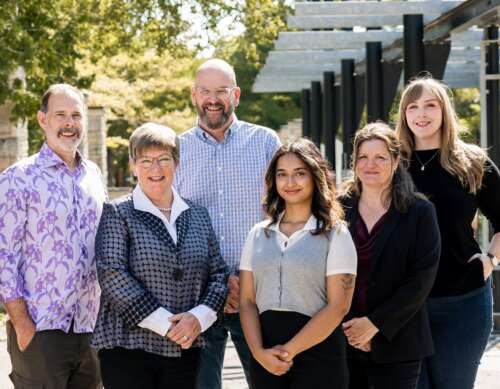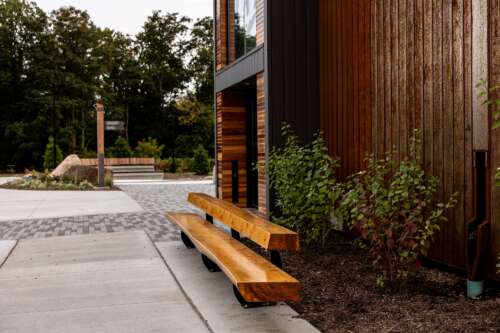Canadian Canoe Museum earns international spotlight thanks to alumni from U of G’s landscape architecture program
When TIME magazine recognized the newly reopened Canadian Canoe Museum in Peterborough as one of the World’s Greatest Places of 2025, it marked a proud moment for University of Guelph alumni. Behind the design of the museum’s 5.3-acre waterfront site is a talented team of U of G landscape architecture grads from Basterfield & Associates (B&A).

The team of U of G landscape architecture grads from Basterfield & Associates
For the B&A design team, which consisted of Brian Basterfield, Helen Batten and Nichelle Leeson, the project was a personal and professional highlight.
“This is the kind of project that many U of G students dream of working on while pulling late nights in the design studio,” says Basterfield, BLA ’81, and the firm’s founder.
“To have it recognized on a global stage by TIME magazine is incredibly fulfilling.”
The museum’s new building, which evokes the curved hull of a canoe, offers a meaningful visitor experience, inside and out. The surrounding landscape, carefully designed by the U of G team, integrates boardwalks, docks and outdoor programming spaces that connect people to land and water in a way that feels both natural and reverent.
Museum’s mission guided design process
 The team’s vision was to blend culture, nature and community in its design.
The team’s vision was to blend culture, nature and community in its design.
The museum tells the story of the canoe as a vessel of culture, history and identity, particularly for Indigenous Peoples.
“The Canadian Canoe Museum houses the history of Canada in a very significant way,” says Batten, MLA ’85. “It was invigorating to help bring that history to life on the shores of Little Lake. The museum’s mission to connect people to the land, and each other, really guided our design process.”
Leeson, BLA ’14, is proud to be part of a team creating spaces that blend culture, nature, and community.
“This project created a living, breathing space that invites people into a cultural narrative,” she says. “One of my favourite elements is the symbolic riverbed in the outdoor classroom. It feels poetic, and it encourages reflection and connection.”
That deep sense of connection between people and place is at the heart of the museum’s design. Including the flowing pathways that echo the movement of water, to ecological features that welcomed wildlife back to the site even before construction was complete.
“The quick return of nesting sandpipers and turtles, and even a curious bear, was one of the most rewarding signs that the design had achieved harmony with the natural world,” says Leeson.
Landscape architecture an evolving field, grounded in Guelph
The BLA program at U of G enjoys a worldwide reputation as a leader in landscape architecture education. It is the only program of its kind accredited by the Canadian Society of Landscape Architects (CSLA), recognized by the American Society of Landscape Architects (ASLA).
As the field of landscape architecture continues to evolve, so do the technologies and philosophy that shape it. Kim Muzatko, BLA ’95, emphasized the increasing role of science, sustainability, and technology in contemporary practice.
“Drone-based site surveys, solar lighting and low-impact development are all becoming standard,” she says. “At the same time, we’re seeing more women in the field and greater collaboration across disciplines.”
That spirit of collaboration was a standout feature of the museum’s design process, which followed an Integrated Project Delivery (IPD) model – a coordinated approach that allows landscape architects to have an equal voice from the outset. “We were embedded in the team early in the design process,” Batten says. “That allowed us to understand the museum’s operational needs and contribute meaningfully to its long-term vision.”
From classroom to Canoe Museum

For recent U of G grad Ciel Pinto, BLA ’24, the Canadian Canoe Museum was part of her introduction to the profession. She joined B&A during her internship, while the project was wrapping up.
“The program at U of G gave me a solid foundation in how the design process works,” says Pinto. “Seeing it come to life through this project helped me understand how flexible and collaborative landscape architecture can be. It was inspiring.”
From internships to senior leadership, the team’s shared academic background helped fuel a sense of purpose.
“The U of G landscape architecture programs prepare students to design for both people and planet,” adds Basterfield. “This project is a reflection of that ethos. It’s about creating spaces that are beautiful, sustainable and meaningful.”
For the B&A team, the Canadian Canoe Museum project was a once-in-a-career opportunity to shape a national cultural space that will educate and inspire for generations.
“It affirms to all our design staff that we can produce spaces that are ecologically sound, memorable and meaningful to a community,” says Basterfield. “And for me, it’s a full-circle moment and proof that the ideas I started exploring as a U of G student can ripple out in ways I never imagined.”
U of G alumni remain at the forefront of innovation in landscape architecture, shaping spaces that tell stories, spark connections and make a lasting impact.


Comments are closed.